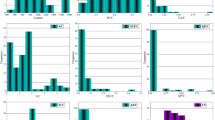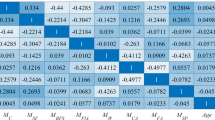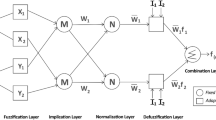Abstract
High-performance concrete (HPC) outperforms regular concrete due to incorporating additional components that go beyond the typical ingredients used in standard concrete. Various artificial analytical methods were employed to assess the compressive strength (CS) of high-performance concrete containing fly ash (FA) and blast furnace slag (BFS). The primary objective of this study was to present a practical approach for a comprehensive evaluation of machine learning algorithms in predicting the CS of HPC. The study focuses on utilizing the adaptive neuro-fuzzy inference system (ANFIS) to develop models for predicting HPC characteristics. To enhance the performance of ANFIS methods, the study incorporates the arithmetic optimization algorithm (AOA) and equilibrium optimizer (EO) (abbreviated as ANAO and ANEO, respectively). Notably, this research introduces novelty through the application of the AOA and EO, the evaluation of HPC with additional components, the comparison with prior literature, and the utilization of a large dataset with multiple input variables. The results indicate that the combined ANAO and ANEO systems demonstrated strong estimation capabilities, with R2 values of 0.9941 and 0.9975 for the training and testing components of ANAO, and 0.9878 and 0.9929 for ANEO, respectively. The results comparison of this study presented the comprehensiveness and reliability of the created ANFIS model optimized with AOA for predicting the HPC’s CS improved with FA and BFS, which could be applicable for practical usages.






Similar content being viewed by others
References
Abualigah L, Diabat A, Mirjalili S, Abd Elaziz M, Gandomi AH (2021) The arithmetic optimization algorithm. Comput Methods Appl Mech Eng 376:113609. https://doi.org/10.1016/j.cma.2020.113609
Aghayari Hir M, Zaheri M, Rahimzadeh N (2022) Prediction of rural travel demand by spatial regression and artificial neural network methods (Tabriz County). J Transp Res
Akkurt S, Tayfur G, Can S (2004) Fuzzy logic model for the prediction of cement compressive strength. Cem Concr Res 34:1429–1433
Anyaoha U, Zaji A, Liu Z (2020) Soft computing in estimating the compressive strength for high-performance concrete via concrete composition appraisal. Constr Build Mater 257:119472
Asteris PG, Skentou AD, Bardhan A, Samui P, Pilakoutas K (2021) Predicting concrete compressive strength using hybrid ensembling of surrogate machine learning models. Cem Concr Res 145:106449
Atici U (2011) Prediction of the strength of mineral admixture concrete using multivariable regression analysis and an artificial neural network. Expert Syst Appl 38:9609–9618
Bayat S, Pishkenari HN, Salarieh H (2019) Observer design for a nano-positioning system using neural, fuzzy and ANFIS networks. Mechatronics 59:10–24
Baykasoğlu A, Dereli T, Tanış S (2004) Prediction of cement strength using soft computing techniques. Cem Concr Res 34:2083–2090
Benemaran RS (2023) Application of extreme gradient boosting method for evaluating the properties of episodic failure of borehole breakout. Geoenergy Sci Eng 226:211837
Bhanja S, Sengupta B (2002) Investigations on the compressive strength of silica fume concrete using statistical methods. Cem Concr Res 32:1391–1394
Bharatkumar BH, Narayanan R, Raghuprasad BK, Ramachandramurthy DS (2001) Mix proportioning of high performance concrete. Cem Concr Compos 23:71–80
Chen CLP, Liu Z, Feng S (2018) Universal approximation capability of broad learning system and its structural variations. IEEE Trans Neural Netw Learn Syst 30:1191–1204
Chopra P, Sharma RK, Kumar M (2016) Prediction of compressive strength of concrete using artificial neural network and genetic programming. Adv Mater Sci Eng 1:1–12
Chou J-S, Pham A-D (2013) Enhanced artificial intelligence for ensemble approach to predicting high performance concrete compressive strength. Constr Build Mater 49:554–563
Chou J-S, Tsai C-F (2012) Concrete compressive strength analysis using a combined classification and regression technique. Autom Constr 24:52–60
Chou J-S, Chong WK, Bui D-K (2016) Nature-inspired metaheuristic regression system: programming and implementation for civil engineering applications. J Comput Civ Eng 30:4016007
Dawei BRY, Bing Z, Bingbing G, Xibo G, Razzaghzadeh B (2023) Predicting the CPT-based pile set-up parameters using HHO-RF and PSO-RF hybrid models. Struct Eng Mech 86:673–686
del Campo I, Basterretxea K, Echanobe J, Bosque G, Doctor F (2011) A system-on-chip development of a neuro-fuzzy embedded agent for ambient-intelligence environments. IEEE Trans Syst Man Cybern Part B 42:501–512
Esmaeili-Falak M, Hajialilue-Bonab M (2012) Numerical studying the effects of gradient degree on slope stability analysis using limit equilibrium and finite element methods. Int J Acad Res 4:216–222. https://doi.org/10.7813/2075-4124.2012/4-4/A.30
Esmaeili-Falak M, Sarkhani Benemaran R (2023) Ensemble deep learning-based models to predict the resilient modulus of modified base materials subjected to wet-dry cycles. Geomech Eng 32:583–600
Esmaeili-Falak M, Katebi H, Javadi A (2018) Experimental study of the mechanical behavior of frozen soils—a case study of tabriz subway. Period Polytech Civ Eng 62:117–125
Esmaeili-Falak M, Katebi H, Vadiati M, Adamowski J (2019) Predicting triaxial compressive strength and Young’s modulus of frozen sand using artificial intelligence methods. J Cold Reg Eng 33:4019007. https://doi.org/10.1061/(ASCE)CR.1943-5495.0000188
Faramarzi A, Heidarinejad M, Stephens B, Mirjalili S (2020) Equilibrium optimizer: a novel optimization algorithm. Knowl-Based Syst 191:105190. https://doi.org/10.1016/j.knosys.2019.105190
Gandomi AH, Alavi AH (2012) A new multi-gene genetic programming approach to nonlinear system modelling. Part I: materials and structural engineering problems. Neural Comput Appl 21:171–187
Han Q, Gui C, Xu J, Lacidogna G (2019) A generalized method to predict the compressive strength of high-performance concrete by improved random forest algorithm. Constr Build Mater 226:734–742
Hussein AM (2016) Adaptive neuro-fuzzy inference system of friction factor and heat transfer nanofluid turbulent flow in a heated tube. Case Stud Therm Eng 8:94–104
Jang J-SR (1993) ANFIS: adaptive-network-based fuzzy inference system. IEEE Trans Syst Man Cybern 23:665–685. https://doi.org/10.1109/21.256541
Kasperkiewicz J, Racz J, Dubrawski A (1995) HPC strength prediction using artificial neural network. J Comput Civ Eng 9:279–284
Khorsheed MS, Al-Thubaity AO (2013) Comparative evaluation of text classification techniques using a large diverse Arabic dataset. Lang Resour Eval 47:513–538
Lai S, Serra M (1997) Concrete strength prediction by means of neural network. Constr Build Mater 11:93–98
Le-Duc T, Nguyen Q-H, Nguyen-Xuan H (2020) Balancing composite motion optimization. Inf Sci (NY) 520:250–270
Lee S-C (2003) Prediction of concrete strength using artificial neural networks. Eng Struct 25:849–857
Lee S, Nguyen N, Karamanli A, Lee J, Vo TP (2022) Super learner machine-learning algorithms for compressive strength prediction of high performance concrete. Struct Concr 24(2):2208–2228
Leema N, Nehemiah HK, Kannan A (2016) Neural network classifier optimization using differential evolution with global information and back propagation algorithm for clinical datasets. Appl Soft Comput 49:834–844
Leung CKY (2001) Concrete as a building material. Encycl Mater Sci Technol 1:1471–1479
Masoumi F, Najjar-Ghabel S, Safarzadeh A, Sadaghat B (2020) Automatic calibration of the groundwater simulation model with high parameter dimensionality using sequential uncertainty fitting approach. Water Supply 20:3487–3501
Mittal A, Sharma S, Kanungo DP (2012) A comparison of ANFIS and ANN for the prediction of peak ground acceleration in Indian Himalayan region. In: Proc. int. conf. soft comput. probl. solving (SocProS 2011) December 20–22, 2011, vol 2. Springer, pp 485–495
Moradi G, Hassankhani E, Halabian AM (2020) Experimental and numerical analyses of buried box culverts in trenches using geofoam. Proc Inst Civil Eng-Geotech Eng 175(3):311–322
Mousavi SM, Aminian P, Gandomi AH, Alavi AH, Bolandi H (2012) A new predictive model for compressive strength of HPC using gene expression programming. Adv Eng Softw 45:105–114
Najafzadeh M, Azamathulla HM (2015) Neuro-fuzzy GMDH to predict the Scour Pile Groups due to waves. J Comput Civ Eng 29:04014068. https://doi.org/10.1061/(ASCE)CP.1943-5487.0000376
Najafzadeh M, Saberi-Movahed F (2019) GMDH-GEP to predict free span expansion rates below pipelines under waves. Mar Georesour Geotechnol 37:375–392
Najafzadeh M, Saberi-Movahed F, Sarkamaryan S (2018) NF-GMDH-based self-organized systems to predict bridge pier scour depth under debris flow effects. Mar Georesour Geotechnol 36:589–602
Namyong J, Sangchun Y, Hongbum C (2004) Prediction of compressive strength of in-situ concrete based on mixture proportions. J Asian Archit Build Eng 3:9–16
Neville A, Aitcin P-C (1998) High performance concrete—an overview. Mater Struct 31:111–117
Nguyen H, Vu T, Vo TP, Thai H-T (2021a) Efficient machine learning models for prediction of concrete strengths. Constr Build Mater 266:120950
Nguyen N-H, Vo TP, Lee S, Asteris PG (2021b) Heuristic algorithm-based semi-empirical formulas for estimating the compressive strength of the normal and high performance concrete. Constr Build Mater 304:124467
Pala M, Özbay E, Öztaş A, Yuce MI (2007) Appraisal of long-term effects of fly ash and silica fume on compressive strength of concrete by neural networks. Constr Build Mater 21:384–394
Rafiei MH, Khushefati WH, Demirboga R, Adeli H (2017) Supervised deep restricted Boltzmann machine for estimation of concrete. ACI Mater J 114:237
Sarıdemir M (2009) Predicting the compressive strength of mortars containing metakaolin by artificial neural networks and fuzzy logic. Adv Eng Softw 40:920–927
Sarkhani Benemaran R, Esmaeili-Falak M, Katebi H (2020) Physical and numerical modelling of pile-stabilised saturated layered slopes. Proc Inst Civ Eng Eng. https://doi.org/10.1680/jgeen.20.00152
Sarkhani Benemaran R, Esmaeili-Falak M, Javadi A (2022) Predicting resilient modulus of flexible pavement foundation using extreme gradient boosting based optimised models. Int J Pavement Eng. https://doi.org/10.1080/10298436.2022.2095385
Topcu IB, Sarıdemir M (2008) Prediction of compressive strength of concrete containing fly ash using artificial neural networks and fuzzy logic. Comput Mater Sci 41:305–311
Van Dao D, Adeli H, Ly H-B, Le LM, Le VM, Le T-T, Pham BT (2020) A sensitivity and robustness analysis of GPR and ANN for high-performance concrete compressive strength prediction using a Monte Carlo simulation. Sustainability 12:830
Wu Y, Zhou Y (2022a) Splitting tensile strength prediction of sustainable high-performance concrete using machine learning techniques. Environ Sci Pollut Res 29:89198–89209
Wu Y, Zhou Y (2022b) Hybrid machine learning model and Shapley additive explanations for compressive strength of sustainable concrete. Constr Build Mater 330:127298
Wu Y, Zhou Y (2023) Prediction and feature analysis of punching shear strength of two-way reinforced concrete slabs using optimized machine learning algorithm and Shapley additive explanations. Mech Adv Mater Struct 30:3086–3096
Yan K, Shi C (2010) Prediction of elastic modulus of normal and high strength concrete by support vector machine. Constr Build Mater 24:1479–1485. https://doi.org/10.1016/j.conbuildmat.2010.01.006
Yeh I-C (1998a) Modeling of strength of high-performance concrete using artificial neural networks. Cem Concr Res 28:1797–1808
Yeh I-C (1998b) Modeling concrete strength with augment-neuron networks. J Mater Civ Eng 10:263–268
Yeh I-C (1999) Design of high-performance concrete mixture using neural networks and nonlinear programming. J Comput Civ Eng 13:36–42
Yeh I-C (2003) Prediction of strength of fly ash and slag concrete by the use of artificial neural networks. J Chin Inst Civ Hydraul Eng 15:659–663
Yeh I-C (2006) Analysis of strength of concrete using design of experiments and neural networks. J Mater Civ Eng 18:597–604
Yeh I-C, Lien L-C (2009) Knowledge discovery of concrete material using genetic operation trees. Expert Syst Appl 36:5807–5812
Young BA, Hall A, Pilon L, Gupta P, Sant G (2019) Can the compressive strength of concrete be estimated from knowledge of the mixture proportions?: new insights from statistical analysis and machine learning methods. Cem Concr Res 115:379–388
Zain MFM, Abd SM (2009) Multiple regression model for compressive strength prediction of high performance concrete. J Appl Sci 9:155–160
Zarandi MHF, Türksen IB, Sobhani J, Ramezanianpour AA (2008) Fuzzy polynomial neural networks for approximation of the compressive strength of concrete. Appl Soft Comput 8:488–498
Zhu Y, Huang L, Zhang Z, Bayrami B (2022) Estimation of splitting tensile strength of modified recycled aggregate concrete using hybrid algorithms. Steel Compos Struct 44:389–406
Author information
Authors and Affiliations
Contributions
ZN: writing—original draft preparation, conceptualization, supervision, project administration. YY: methodology, software, validation, formal analysis. JS: language review, formal analysis, software, validation.
Corresponding author
Ethics declarations
Conflict of interest
The authors declare no competing of interests.
Additional information
Publisher's Note
Springer Nature remains neutral with regard to jurisdictional claims in published maps and institutional affiliations.
Rights and permissions
Springer Nature or its licensor (e.g. a society or other partner) holds exclusive rights to this article under a publishing agreement with the author(s) or other rightsholder(s); author self-archiving of the accepted manuscript version of this article is solely governed by the terms of such publishing agreement and applicable law.
About this article
Cite this article
Niu, Z., Yuan, Y. & Sun, J. Neuro-fuzzy system development to estimate the compressive strength of improved high-performance concrete. Multiscale and Multidiscip. Model. Exp. and Des. 7, 395–409 (2024). https://doi.org/10.1007/s41939-023-00219-z
Received:
Accepted:
Published:
Issue Date:
DOI: https://doi.org/10.1007/s41939-023-00219-z




